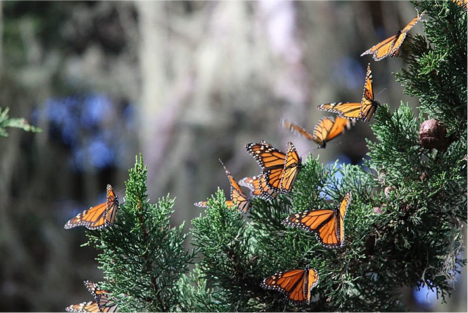Monarch Butterfly in Decline

Monarch butterflies overwintering in Pacific Grove, CA. Joanna Gilkeson/USFWS
Why the butterfly is in decline
Numerous natural disasters have happened simultaneous throughout the United States and Mexico, causing the Monarch butterfly to be in serious decline and near extinction. Currently, 20,000 butterflies have been counted in the western migration route, an 86% decline since last year.1 This precipitous decline is said to be “affected by shared threats: a reduced abundance of milkweed plants caused by an increase in genetically modified herbicide-resistant crops, a loss of nectar resources from flower plants, and degraded overwintering forest habitats due to deforestation.”2 Monarchs lay their eggs on milkweed, which the larvae feed on. In addition, increasingly severe storms occurring with climate change can have a harmful effect on the Monarch. During one such winter storm, as many as 500 million Monarch butterflies were said to have perished.3
The importance of milkweed
Milkweed used to be abundant along the sides of roads and growing alongside crops grown for food. With the spraying of the herbicide Roundup and the use of herbicide-resistant crops, milkweed, essential to the existence of the Monarch, has declined.
Fire
Another factor reducing the population of Monarch butterflies has been fire. The Western Migration of butterflies flew through fire-ravaged California, the air filled with smoke from burning houses, forests, household cleaners, pesticides or herbicides, plastic and other noxious chemicals. Global warming has contributed to more frequent and devastating fires.storms travel more slowly through the landscape dropping more rain than normal. Warmer air is able to hold more humidity, therefore, storms can be more intense because they carry more water. The additional rain provides more water for grass to flourish that can eventually burn. The antiquated policy of fire suppression, for decades, has not helped diminish wildfires.
Bark beetle infestation and the forests
It is believed that 129 million pine trees are dead from bark beetle infestation and drought. Historically, bark beetles would die off as winter temperatures froze them. Today, the temperature is never cold enough to kill them, so they feed year-round, hastening the demise of the pine forest.
The central migration flock of Monarch butterflies would nest in the forests of Mexico, now ravaged by the bark beetle. The clearcutting of forests to increase farm cropland also contributes to the problem.
A plan to increase the population of monarchs
Two conflicting plans are being developed to save the Monarch butterfly. One plan by the Environmental Defense Fund is purchasing land for milkweed habitat along migration routes. Farmers willing to allow milkweed to grow among their crops have also been providing habitat for the butterflies.
A second plan that is well-meaning but could be counterproductive is provided by the U.S. Fish and Wildlife Service. “The Fish and Wildlife agency has decided to cultivate the milkweed plant in refuges and several other areas under its control to develop a natural habitat in 200,000 acres of land and 35 corridor Interstate, from Texas [to] the state of Minnesota … the main area where above 50% of Monarch butterflies migrate.“3. The agency is offering to sell to the general public milkweed that can be planted along roadsides, forests, parks and in backyards. With the disappearance of 97% of our local milkweed, tropical or Mexican milkweed has been planted as a substitute to our local species. With the planting of these non-native milkweed species, Monarch butterflies have become disoriented and confused. Instead of continuing their migration, they have stayed where they are and have become infected with parasites.4
Sixth extinction
The problem of extinction is not particular to Monarch butterflies; according to the World Wildlife fund, some experts estimate that 10,000 species go extinct every year. This would make 50% of all species extinct by the year 2100. Unfortunately, insects are especially vulnerable. Insects are often food for larger creatures. With the reduction of insects, we can expect other creatures to go extinct as well.
If we stop adding global-warming-causing carbon to our atmosphere today, the amount of carbon that remains will linger for hundreds of years into the future. Although purchasing electric cars, not eating meat, and solar panels on the roof are helpful, they are not enough to solve our climate crisis. We must enact serious legislation on the federal level that can correct our dependence on the fossil fuel industry. The extinctions are irreversible, and if they continue, we are threatening the health and wellbeing of future generations.
Hope for the future
Today, the cost of renewable energy is decreasing 10% every year, despite the fact that the fossil fuel industry is being subsidized at a rate 40 times greater than the renewable energy sector. Eventually, this will allow all nations to be able to reach the same renewable energy output as Germany did one day in the recent past. That day, Germany provided 81% of its total energy requirement from renewable sources.
~~ Glenn Rogers
Footnotes
1 http://blogs.edf.org/growingreturns/2018/12/04/western-monarch-butterfly-population-decline/
2 https://www.inverse.com/article/52340-monarch-butterfly-california-decline
3 https://www.monarch-butterfly.com/vanishing-monarch-butterflies.html
4 https://www.inverse.com/article/52340-monarch-butterfly-california-decline

